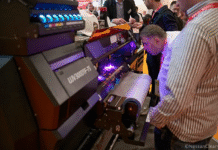Fujifilm India recently launched its super-wide UV printer, Uvistar Hybrid 320, foraying into wide-format printer portfolio. The official launch was held at the company’s state-of-the-art demo center in Mumbai. Uvistar Hybrid 320 is a versatile UV production printer with the flexibility to produce different kinds of display print—right from super-wide roll printing to multi-sheet rigid printing.
The company believes that the new product will offer the potential to broaden production capabilities with one investment. It has been specifically designed to build on Fujifilm’s position as one of the leaders in the super wide format market, providing printers with the very best in quality, flexibility and productive wide format inkjet technology. The product is driven by Fujifilm’s patent technology and is capable of producing high quality jobs at affordable costs, thereby offering a value for money proposition to price-conscious Indian customers.
SM Ramprasad, EVP – Graphic Arts division, Fujifilm India said, “The Uvistar Hybrid 320 is more than just another great addition to our wide format line-up. Its launch is the next vital step in ensuring that Fujifilm’s complete portfolio of wide format products delivers the necessary solutions to all customers—regardless of their needs in terms of print size, turnaround time or run volume. Fujifilm is delivering on its objective to provide new solutions that feature the very latest inkjet technology to suit every printer’s needs.”
“This launch is the logical step in this journey and it ensures that printers in the super wide market maintain access to the very latest technology in order to maximize quality and productivity, and grow their businesses,” he added.
Speaking during the launch, Yasunobu Nishiyama, managing director, Fujifilm India said, “With the launch of Uvistar Hybrid 320, we aim to strengthen our presence in the Indian graphic art market. The graphics arts business is one of the most important drivers for Fujifilm’s growth in the Indian market. With our world-class printing technology, we are focused on delivering high-quality, technically advanced print solutions that help printers develop competitive advantage and grow their businesses.”
Shift towards eco-friendly printing
In India, wide format caters to printers based on solvent and eco-solvent technology. On the other hand, the company believes that the future looks promising for UV printing as it is the best way to print in an eco-friendly manner. Experts from the company highlighted how the European nations have started adopting UV printing and are giving up solvent-based technology. UV printing technology, according to them, will prevail. Ramprasad added, “Consciousness towards eco-friendly products is growing and so is the UV segment at 40%. The whole market of wide format is pegged at around Rs. 750-800 crore, which includes inks, printers and other similar segments. Currently. we have 30% market share when it comes to wide format, which we see will go up to 40 to 50% down the line.”
Ramprasad also informed that the UV inks from the company are GREENGUARD certified, which is one of the rigorous and comprehensive standards for low indoor emissions.
Promising future for wide format
Speaking to Indian Printer and Publisher, Ramprasad stated, “In India wide format is a category which has a promising growth. India’s commercial market is coming down slowly but is gaining speed in terms of high-end applications, which demand greater quality. All the metro cities in India provide immense branding opportunities giving more jobs to printers. In the coming years, printing jobs for restaurants, interior decoration, malls, metro stations and others will pick up pace. These jobs require high precision and it is to cater to this need that Fujifilm has come with its hero product.”
The product
The new Uvistar Hybrid 320 is a 3.2 meter, combination flatbed and roll printer, capable of producing high quality output at speeds of up to 201 square meters an hour. Utilizing Fujifilm’s Dimatix Q-Class print-heads and Uvijet UV inks, the Uvistar Hybrid 320 prints full grayscale output at an exceptional quality level and delivers a wide gamut of vibrant colors. The press is available in a nine-channel configuration with CMYK, Lc, Lm, Lk, Orange and White ink channels, which dramatically boosts performance to achieve speeds of up to 201 square meters an hour.
Product innovations
Several innovative technologies have been combined to develop the product, so that it can achieve the desired breakthrough in terms of speed, quality and versatility. This has made the Uvistar Hybrid 320 stand apart from the competition.
The first innovation is the use of Fujifilm Dimatix Q-Class print-heads and VersaDrop jetting technology. These heads enable the press to image in grayscale with droplet sizes ranging from 10–30 pl, which produce the finest details at the fastest speeds. Taking full advantage of nine ink channels, the new printer is able to produce outstanding image quality with the inclusion of orange ink increasing the color gamut by 30%.
Another innovation is its patented tri-lobal belt and six-zone intelligent vacuum system. This system delivers best-in-class media handling and ensures that all types of substrates track accurately in roll or flatbed mode. Additionally, a dancer bar with spreaders keeps even the most difficult roll media from wrinkling before it enters the print area. Rear pinch rollers engage as rigid material moves from the print area on to the exit tables.
The wide color gamut is possible with Fujifilm’s new Uvijet US high performance ink, with CMYK, Lc, Lm, Lk, Orange and White in the standard ink set. The lights and Orange expand the color gamut to match challenging Pantone and corporate brand colors, while the highly opaque White provides excellent coverage, with the ink set delivering excellent adhesion to a broad range of substrates.
It also has a ‘continuous board’ capability that increases productivity when feeding multiple sheets of the same stock during production. This feature results in saving of precious time between sheets as the print carriage continues moving. No time is lost due to the carriage returning to its ‘park’ position, requiring the job to be started again.
















